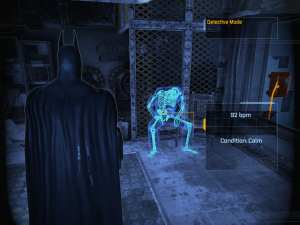Arkham City: What It All Means
At its broadest strokes, the story of Arkham City is about a supervillain committing crimes of a sort and scale normally only practiced by nations. He separates out a subset of the population that he holds in contempt, ghettoizes and deprives them of adequate food and warmth and legal recourse, and goads them into retaliating as a pretext for massacre. In his villain rant at the end, he talks about repeating the experiment in other cities, but he needn’t bother. At its core, it’s already a fairly widespread practice.
And it’s fairly significant that the story pits Batman against this system. There’s always been a bit of a fascist streak to the character, surfaced most clearly in the works of Frank Miller, but it’s never simple. The mere fact that he wants to be tough on crime but doesn’t like guns makes him a political anomaly in America, and the story here emphasizes conflicts of that sort. Hugo Strange and Batman have the same goal: a city without crime. They only disagree on the acceptable means toward that end. Batman’s judgment is that the ends don’t justify the means, but he’s still perfectly willing to brutalize the same people as Strange, stopping only at actual killing. 1In the peculiar world of comics and videogames, anyway. Batman is routinely beating people so severely that they’re still lying on the ground unconscious a half an hour later. In real life, this would definitely kill some of them, and cause permanent brain damage to the rest.
The themes are a little confused — or, to be more charitable, they’re not didactic, and let things be fuzzy and complicated — but they’re strongly reiterated, and they culminate in a satisfying confrontation, Batman finally climbing the central tower to confront the man looking down on everyone else. So it’s a little consternating that the story swerves away at the end. The final chapter is a twisty one, with revelations of schemes on the part of Ra’s al Ghul, Joker, and Clayface. Clayface’s mere presence is a surprise — he didn’t seem to be a factor in earlier chapters, but turns out to have appeared in multiple cutscenes previously without the player knowing it was him. I described the Joker previously as trying to steal the spotlight from Strange, and in the end, he succeeds, albeit by dying for it.
Or appearing to die, anyway. It’s hardly the first time. Even the inmates comment on it in their idle chatter, if you go back in after the story’s end to finish off side-quests. They also question why they’re still there now that the facility’s officially being shut down. They really have quite a lot of dialogue where they say things the player is thinking, or could be thinking — there’s even a bit where a thug says “Arkham City’s worse than the old one. I should get a refund.”
Anyway, any woke points the game earns from its distrust of the carceral state are to some extent canceled out by the way Joker is kind of gay-coded, outright flirting with Batman and even singing a love song to his voice mail over the ending credits. Arguably, he only does it to get under Batman’s skin. In fact, he does this literally at one point, injecting Batman with his own blood — although to those of us who remember the AIDS crisis, having the bad guy deliberately infect someone with a bloodborne disease looks a lot like familiar gay fear-mongering. Regardless, flirtation is of course useless against Batman, at least in this incarnation. His will-driven stoicism makes him completely unflirtable, as well as making him easier to animate.
I’ll say this for the final chapter: It has one of the best tactical sequences in the game, one that finally uses the geometry of the city to its full potential. Throughout both this game and Arkham Asylum, there are “predator” sequences, where you’re in a large but confined room with a bunch of heavily-armed baddies, and the best way to take them all out is with stealth, sneaking up on isolated individuals in places where the others can’t see you. The approach to the final fight is essentially a predator sequence spread out over the city, subduing snipers on the rooftops in just the right sequence.
One last thing. I’m a little surprised at one Chekov’s gun that never fired: The “mechanical guardians” in Wonder City never come to life. Why are they even there? Just as a relic of an abandoned subplot?
| ↑1 | In the peculiar world of comics and videogames, anyway. Batman is routinely beating people so severely that they’re still lying on the ground unconscious a half an hour later. In real life, this would definitely kill some of them, and cause permanent brain damage to the rest. |
|---|
 Comments(0)
Comments(0)